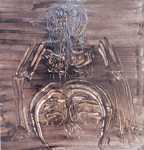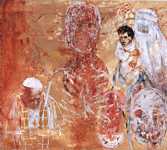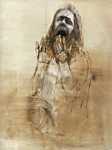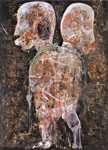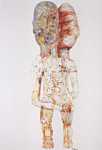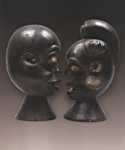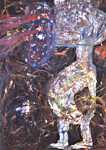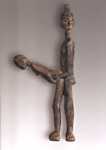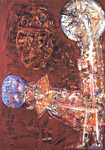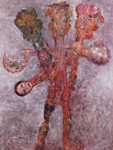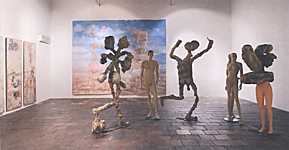2000 -
2009
New Age Cycle
|
Distant Ancestor
2001 Oil on canvas, 150x150 cm |
Magic
in Art Most people in the so-called Western world are convinced that the greatest and most cultivated art is only the kind that is exhibited in museums, having been created from the time of ancient Greece up to the present day. It's almost strange how quickly people have forgotten the turning point that occurred about a hundred years ago with the discovery of the primitive art of Africa, Oceania and other first nations. This discovery, this earth-shattering event, overturned existing rules and canons so radically that a new anatomy of art emerged - Cubism. This is possibly why the term `primitive art' is increasingly being replaced by the term `primal art', and why we are beginning to ask ourselves the ever more pressing question - aren't these two forms of art equal to each other? And, with their unbounded fantasy, magical qualities and noble forms, don't these works often surpass works that we have venerated for thousands of years? In 1949 .Jean Dubuffet wrote, "From one metropolis to another, everyone exquisitely apes each other, practising art that is tirelessly copied everywhere, that is as artificial as Esperanto; can we call it art at all ?" J. A. 2001 |
|
|
The Holly Father
2001 Acrylic on canvas, 150x180 cm |
||
|
Scream
2001 Acrylic on canvas, 150x110 cm |
||
|
Guardian
2001 Acrylic on canvas, 150x110 cm |
||
|
Crocodile
2001 Acrylic on canvas, 150x150 cm |
View Back and Forvard
Cycle
| Double
Figure Lobi people - Burkina Faso 86 cm |
Double
Figure (Joined) 2002 acrylic on canvas 150x110 cm |
Tiva 2002 acrylic on canvas 150x110 cm |
|
If there is one lesson that the Prague of Jiří Anderle regularly teaches its visitors and inhabitants, it is that no dimension of experience need necessarily be as simple as it might appear. Communities within communities, history within history, ideas within ideas, even time flowing backwards in the form of Bohemian `Baroque-Gothic' architecture - invisible and unexpectedly interconnected layers form the Prague psyche. In this city, it continually seems that somehow `everything is the other way round'. The magical encounter between the spheres of the prosaically objective and the bizarrely subjective that brought the world Rudolphine alchemists, Arcimboldo's grotesque figurative allegories and Kafka's hall of mirrors is the same phenomenon underlying the artistic expression of Jiří Anderle. He shows us the way into his labyrinth, and it is then up to us to thread our way through its multitude of levels. Anderle is a master of synthesis, who at any moment brings together a rich diversity of elements into an integral whole. Ultimately, his kaleidoscopic orchestrations tell us of the inescapable complexities linking the various dimensions of human existence - past and present, the rational and irrational, inward and outward being, the individual psyche and collective fate.
|
||
| Guardians
of a Tribal Altar Igbo people 42 cm |
Dialogue 2002 acrylic on canvas 90x120 cm |
|
| Fetisch Senufo People Ivory Coast 96 cm |
Creature
with Radiant Eyes 2002 acrylic on canvas 150x110 cm |
|
Ice
Cream I 2000 acrylic/cotton 115 x 135 cm |
A
never-ending dialogue J. A. |
|
Freee-flowing
Love (Embarrassing Scenes) 2006 oil on canvas 135x105 cm |
||
Blue
Sky (Summer) 2006 acrylic, oil on canvas 70x50 cm |
||
Seven
Guardians (The Prlmordlal), 1999 Indián ink, acrylic on canvas Dance in front of a Blue Sky (Tree of Life), 2006 acrylic on canvas Indifference, 2009 plaster sculptures, plastic mannequins |
